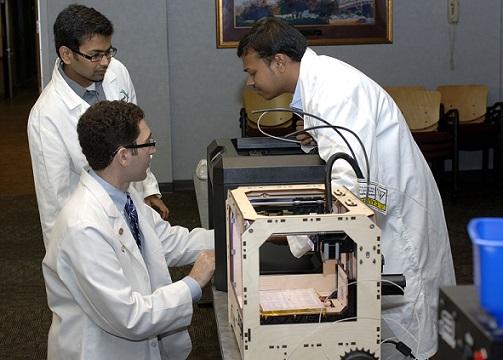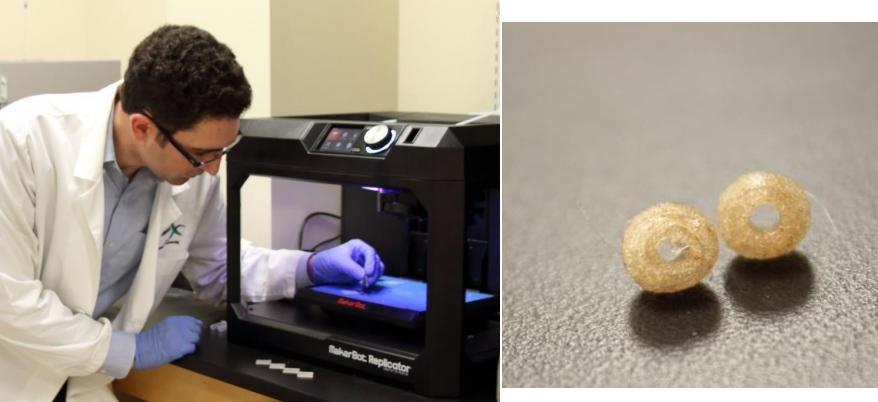Bioactive 3D Printing for Effective 3D Printed Drug Therapy, LSU Researchers Awarded $40K for New Medical Center
 At my fourth grade picnic, I ran up the steps of a gazebo and fell on my knee onto the brick steps. The cut was so deep it severed nerves, so I didn’t feel it; I didn’t even know I’d been hurt until one of the chaperones grabbed my arm. My mom and I got to urgent care pretty quickly, where a doctor stitched me up. I didn’t watch, as I was petrified of needles as a child, and kept a magazine firmly over my face throughout the procedure. I was extra-afraid, too, because I remembered a few years ago when my older sister had stitches in her knee and told me it was way worse having them removed than getting them in the first place. Because my wound was so deep, though, I was given special stitches that ultimately dissolved into my bloodstream and I didn’t need them taken out. That was a huge relief!
At my fourth grade picnic, I ran up the steps of a gazebo and fell on my knee onto the brick steps. The cut was so deep it severed nerves, so I didn’t feel it; I didn’t even know I’d been hurt until one of the chaperones grabbed my arm. My mom and I got to urgent care pretty quickly, where a doctor stitched me up. I didn’t watch, as I was petrified of needles as a child, and kept a magazine firmly over my face throughout the procedure. I was extra-afraid, too, because I remembered a few years ago when my older sister had stitches in her knee and told me it was way worse having them removed than getting them in the first place. Because my wound was so deep, though, I was given special stitches that ultimately dissolved into my bloodstream and I didn’t need them taken out. That was a huge relief!
 Doctors have long recognized the additional trauma of having to remove anything put into the human body during medical procedures, as removing stitches, implants, or other temporary structures can re-injure an area, add healing time, or mentally discomfort the patient. Fortunately, dissolvable and other bio-friendly and -adaptable technologies have come a long way in treating medical conditions which can now simply be absorbed into the body in a non-traumatizing manner upon completion of their treatment.
Doctors have long recognized the additional trauma of having to remove anything put into the human body during medical procedures, as removing stitches, implants, or other temporary structures can re-injure an area, add healing time, or mentally discomfort the patient. Fortunately, dissolvable and other bio-friendly and -adaptable technologies have come a long way in treating medical conditions which can now simply be absorbed into the body in a non-traumatizing manner upon completion of their treatment.
Dr. Jeffrey Weisman, the first person to pursue a new joint PhD/MD certification offering, graduating with a PhD in Biomedical Engineering in November 2014 from Louisiana Tech and expected to graduate with his MD from LSU Health Sciences Center-Shreveport in May 2016, has been making incredible strives in bringing together the latest in technology to the health arena. Last summer, we covered his work in using commercial-grade desktop 3D printers in making drug emitting implants for cancer treatment and infection.
Dr. Weisman, working with an impressive team of researchers, has been at the helm of developing Bioactive 3D Printing, which is set to change the landscape of drug delivery for patients around the world.
“The way that Osteomyelitis or bone infection would currently be treated, you’d go ahead and you’d mix up a bone cement, which is kind of like mixing up Play-Doh, and you mix it up and put antibiotics in it… you end up where you can mold it into these beads or pellets that can be implanted into the bone site of the infection,” Dr. Weisman told KTBS. “Then what will end up happening is it will clear up the infection, and 6 weeks later they’ll have to go back in and remove these, whereas what we’re able to do as a new novel treatment is by being able to 3D print both a bioabsorbable and antibiotic alluding bead is we can go ahead and implant that, and 6 weeks later we don’t have to go any remove it from the body. So that reduces the morbidity of having another surgical procedure once the bone infection is cleared up.”

Dr. Weisman working on developing 3D printed drug delivery systems in the lab with Uday Jammalamadaka and Karthik Tappa
By providing drug delivery in such a manner, applications such as the treatment of bone cancer can be streamlined to avoid more surgery while upping the treatment potential by a focus on localized treatment.
Localized treatment is critical in treating such sensitive diseases as bone cancer.
“When a surgeon would go in and remove a tumor, such as an Osteosarcoma, we can go in and we can do a scan of that wound or bone defect that’s been removed and we can actually 3D print a filler that can go in there that’s basically alluding a chemotherapeutic,” Dr. Weisman says of the potential of their 3D printed drug delivery in bone cancer treatment. Regarding the use of localized treatment, he says, “One of the biggest advantages to that is with systemic drug delivery you’ve got to really worry about a lot of things such as nephrotoxicity, or basically a poor reaction to the drug, whereas going in a doing something more localized, you can do a much lower dosage of the drug you’re trying to treat with…so you can reduce the risk of an adverse reaction.”
 In recognition of the huge potential of bioactive 3D printing, the research group has recently been awarded a $40,000 grant/investment to open the first Shreveport, LA area medical 3D printing lab. Currently working in a lab provided by the Biomedical Research Foundation, the new 3D printing lab will pave the way to more targeted work in the medical field–and the team is hoping to gain additional funding, from a federal grant, to expand the equipment at their disposal.
In recognition of the huge potential of bioactive 3D printing, the research group has recently been awarded a $40,000 grant/investment to open the first Shreveport, LA area medical 3D printing lab. Currently working in a lab provided by the Biomedical Research Foundation, the new 3D printing lab will pave the way to more targeted work in the medical field–and the team is hoping to gain additional funding, from a federal grant, to expand the equipment at their disposal.
“The next question and the really difficult one is,” said Dr. Weisman, “is this something that can help a patient and how do we go ahead and commercialize this?”
Currently working toward that goal of expanding the research and ultimately offering the drug delivery systems to a wider patient base, Dr. Weisman and team will surely see the benefits of having a dedicated research lab to fully develop their bioactive 3D printing concepts. Let us know what you think of these developments in the Bioactive 3D Printing Research forum thread over at 3DPB.com.
Subscribe to Our Email Newsletter
Stay up-to-date on all the latest news from the 3D printing industry and receive information and offers from third party vendors.
Print Services
Upload your 3D Models and get them printed quickly and efficiently.
You May Also Like
Reinventing Reindustrialization: Why NAVWAR Project Manager Spencer Koroly Invented a Made-in-America 3D Printer
It has become virtually impossible to regularly follow additive manufacturing (AM) industry news and not stumble across the term “defense industrial base” (DIB), a concept encompassing all the many diverse...
Inside The Barnes Global Advisors’ Vision for a Stronger AM Ecosystem
As additive manufacturing (AM) continues to revolutionize the industrial landscape, Pittsburgh-based consultancy The Barnes Global Advisors (TBGA) is helping shape what that future looks like. As the largest independent AM...
Ruggedized: How USMC Innovation Officer Matt Pine Navigates 3D Printing in the Military
Disclaimer: Matt Pine’s views are not the views of the Department of Defense nor the U.S. Marine Corps Throughout this decade thus far, the military’s adoption of additive manufacturing (AM)...
U.S. Congress Calls Out 3D Printing in Proposal for Commercial Reserve Manufacturing Network
Last week, the U.S. House of Representatives’ Appropriations Committee moved the FY 2026 defense bill forward to the House floor. Included in the legislation is a $131 million proposal for...



































